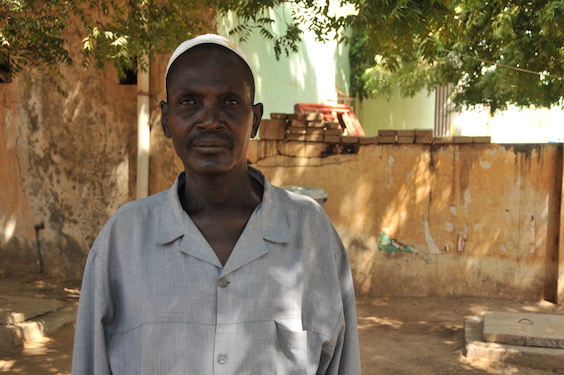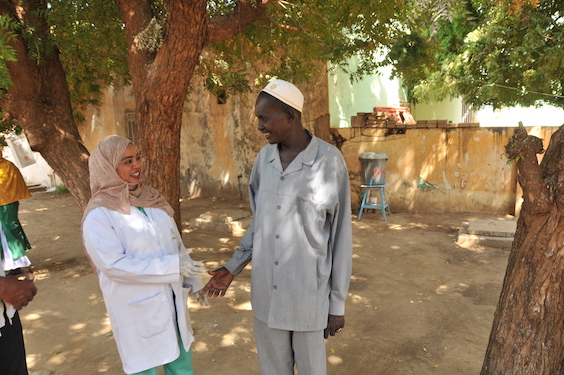Acute watery diarrhoea (AWD) has affected Sudan since August 2016, infecting over 36 000 people and killing over 800. Over the next 3 weeks, read along as we introduce you to the people living with and fighting against this deadly disease.
This week: Hammad Yousif Ibrahim (42) from Kosti, White Nile State, was treated for life-threatening AWD at WHO's cholera treatment centre in Kosti.
 Hammad Yousif Ibrahim outside the cholera treatment centre in Kosti where he received treatment for AWD.
Hammad Yousif Ibrahim outside the cholera treatment centre in Kosti where he received treatment for AWD.
Hammad first noticed something was wrong when he felt sick to his stomach and developed greyish, watery diarrhoea. Hammad: “It was much more than any normal diarrhoea, so I knew something was off,” he says. At the local hospital in Kosti, the capital of White Nile State, the health care professional referred him to a nearby cholera treatment centre, or CTC, that the State Ministry of Health had established. A CTC is an emergency health facility focused on treating moderate and severe cases of AWD. Sudan’s Health Ministry has set up dozens of these CTCs across the country since the start of the outbreak in August of 2016, with support from WHO.
When Hammad arrived at the CTC, he feared that he would die because he was so dehydrated. People suffering from AWD lose fluids very quickly, through watery diarrhoea and vomiting. In severe cases, a patient can pass away from dehydration within hours if he or she does not receive treatment.
Thankfully for Hammad, the staff at the CTC was ready, trained and equipped. With the support from Sudan's Health Ministry, and from the World Health Organization (WHO) through the Sudan Humanitarian Fund (SHF), the clinic had received medical supplies, training and information on how to treat AWD, as well as essential funds to support health staff including doctors and nurses.
One of those nurses is Somaia Abdallah (28), who started working in the CTC in Kosti when AWD spread to White Nile State. At the height of the outbreak, Somaia says, 120 patients were coming into the CTC every day. Hammad was one of them. The attending CTC doctor, together with nurse Somaia, noticed his loose skin, a symptom of life-threatening dehydration. Hammad immediately received several cannula, thin tubes for administering medicine or fluids, in his arms and legs. Nurse Somaia then gave him fluids and antibiotics to stem the disease. After four days, Hammad started feeling better.
 Nurse Somaia (l) and Hammad (r) at the CTC in Kosti.
Nurse Somaia (l) and Hammad (r) at the CTC in Kosti.
The day after Hammad was discharged from the CTC, other members of the CTC team, with support from WHO, visited him at home to see how he was doing. The team also provided information on how to prevent future infections, and Hammad's home was disinfected thoroughly.
WHO supports the Sudanese Government’s response plan with these life-saving activities since August 2016 across Sudan. In the CTCs, patients lives are saved. In the communities, WHO and Health Ministry staff are working around the clock to teach proper handwashing, avoiding open defecation, boiling water and more. Teams are going around to spray fly and mosquito breeding sites, to reduce the amount of bugs that can spread the AWD pathogens. Due to this tireless work, AWD case numbers have fallen from a peak of nearly 2,000 per week last June, to around 40 right now. However, to ensure that the outbreak is fully stopped, WHO’s activities will continue until all of Sudan is reporting zero new cases for a consecutive four-week period.
Hammad in the meantime has a new lease on life. He says that when the CTC staff allowed him to go home, his relatives cried because they had not expected him to survive. “The angel of death was pulling on my soul”, Hammad says, as he beams a smile at the nurse that saved his life, “but thankfully, Somaia pulled harder.”


